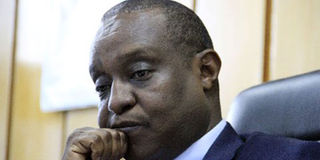Next budget to focus more on education, health sectors

Treasury Cabinet Secretary Henry Rotich during a press conference. Mr Rotich says that the next capital outlay will aim at completing the many infrastructure projects that are currently under way countrywide and also channel investments to social sectors. PHOTO | DIANA NGILA | NATION MEDIA GROUP
What you need to know:
- Treasury also singles out capital investments in energy, infrastructure, ICT sector and other development expenditure in general.
- It also notes that budget submissions by ministries and departments will “critically be reviewed” with a view to removing any non-priority expenditures and shifting the savings to the priority programmes.
Kenya’s national budget for the financial year 2016/2017 will concentrate on education and health sectors but also investments in energy and infrastructure will play a major role, the National Treasury has revealed.
Treasury Cabinet Secretary Henry Rotich says in the 2016 Budget Policy Statement to be tabled in Parliament, that the next capital outlay will aim at completing the many infrastructure projects that are currently under way countrywide and also channel investments to social sectors.
“Taken as a whole, the budget for Financial Year 2016/17 will focus on enhancing support to social sectors (social protection, health and education). These will continue to receive the bulk of budgetary resources, especially education and health sectors. The social sectors will receive 29.8 per cent of total discretionary expenditures,” says Treasury in its plans.
Treasury also singles out capital investments in energy, infrastructure, ICT sector and other development expenditure in general, underscoring Kenya’s expansion streak in the sectors in recent years.
“This reflects the priority assigned capital investments in our growth objectives. With an overall allocation of 23.4 per cent of total discretionary expenditures, the energy, infrastructure and ICT sector will be receiving the second largest share of the resource envelope,” it says.
Other priority areas include security, social protection, youth and agriculture.
Meanwhile, in a bid to improve budgeting, Treasury plans to compel ministries and State departments to align their budget requests with relevant projects.
“In the Financial Year 2015/16, the National Treasury coded the projects in Ifmis as “Heads”. With effect from Financial Year 2016/17, the detailed development budget structure will include individual projects being implemented by ministries and departments regardless of the source of financing, in order to improve monitoring and reporting on project implementation,” says Treasury.
It also notes that budget submissions by ministries and departments will “critically be reviewed” with a view to removing any non-priority expenditures and shifting the savings to the priority programmes.
“The Second Medium Term Plan (2013-2017) and the priorities of the Jubilee administration will guide resource allocation. The government is committed to improving the implementation and absorption capacity of projects,” says Treasury.
It projects the economy to grow by 6 per cent in 2016 and 6.5 per cent over the medium term.





